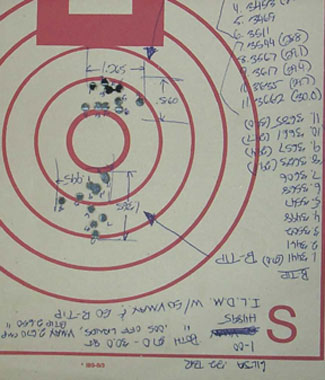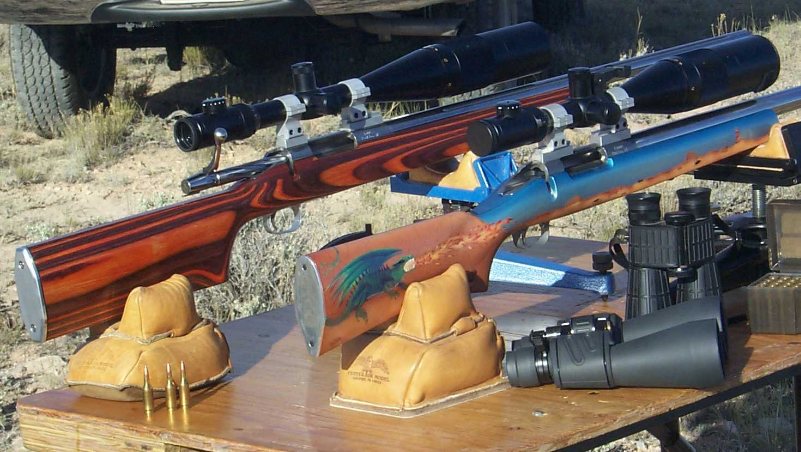ILDM Load Testing
by Dave Affleck
The Audette load testing technique, also known as the incremental load development method (ILDM), ladder testing and probably a few other name as well, has been around for several decades.
The basic methodology is simple. You load a series of cartridges, each with a different powder charge, in regular increments – ending at maximum. How low you want to start, what size increment, how many shots etc… are basically dependent on the size of the cartridge. Generally speaking, best results will be obtained from smaller increments and a larger spread – more shots in other words. The tests series pictured here consist of only 11 shots each, 20 is a more typical and thorough number of shots.
To proceed, you prepare a series of loads with a particular bullet and powder, each one going up in charge weight incrementally, and shoot them all at the same aim point. It is most important to carefully note the location of EACH shot. Plot them all on a replica of the target you are shooting, or do it however best suits you, but make sure you know where every shot lands in relation to the others. It’s very important to do this testing under good conditions so as not to taint the data with “flyers” caused by changing winds etc… What you will end up with, is a graphical display, on the target, of barrel harmonics. You will be able to see the “sweet spots”, displayed as “clumps” of shots that land together. You are mostly looking at vertical here, but if conditions are really good you’ll even see the horizontal component pretty clearly. The mistake that many people make, is shooting the test series from too close. Many people give way too much credit to the chrony data as well.

In the test series pictured here, I used two different bullets (50 gr. Vmax and 50 gr. Ballistic Tip), with the same powder, primer and seating depth relative to the lands. After firing the first series (B-tips), I simply turned the target upside down to fire the second on the same sheet. This series was fired at 300 yards, with my Nesika/Lilja .22BR. Note the two obvious “clumps” or “nodes” evident with the Vmax. While the B-tips are giving much less clumping and much more vertical dispersion. In this case, the Vmax were the obvious choice, as was a load from the middle of the higher velocity “clump” (shots 7,8,9,10 & 11). Later, further testing with this load confirmed that it is a SUPERB performer. It is also well worth noting, that the total group size for all 11 shots, each with a different powder charge, at 300 yds, is under .5 MOA. This is obviously an incredibly forgiving, non-temperamental combination – a situation I’ve found common when working with the .22BR.
I feel that 300 yards is the minimum distance for using this method effectively. Sometimes a really good load, or sweet spot, will show up in the long range shooting that would never have been apparent from 100 yd targets or from chrony data. I’m not sure how well I can explain what I mean, but I’ll try. A good long range load is basically one that does not produce un-warranted vertical dispersion. One might think, and logically so, that the load with the lowest velocity spread will be the one to produce the least vertical dispersion at long range. It often does not work out this way though. Sometimes a load that does not have the lowest velocity spread will have the least vertical spread on target downrange (300+ yd’s). What I believe happens here, is that this is a load that has the bullet exiting the barrel at or near a “sweet spot” – that is exiting at one end of the barrels vibration travel. My guess is that perhaps the slightly faster shots (shorter time in bbl), leave the muzzle while it is still moving up (over simplify the vibration to think of it as simply up and down), and have a very slightly lower departure angle than the slightly slower shots which are in the bbl a bit longer and leave the muzzle at the top of it’s movement, with a very slightly steeper departure angle. The idea here being, that the small differences in velocity are being “cancelled out” by happy coincidence of muzzle position relative to bullet time in barrel. Of course, the ideal is to have the lowest possible velocity spread and bullet exiting the muzzle in a sweet spot too (“sweet spot”, “node”, same thing). Doing the incremental testing at long range, over a chrony, allows you to see sweet spots related to bbl harmonics on target, and velocity/load density data from the chrony, simultaneously, giving you a much deeper picture of load performance than is possible without the long range shooting part.
The biggest problem with doing the testing from too close is that you often end up with a nice tight group that doesn’t provide near the data that a more dispersed, longer range group would.
I’ve used this technique a number of times, and it is quite effective!
– Dave Affleck



